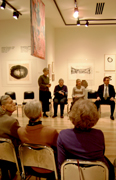Making connections
March 9, 2008
Art lovers assembled Tuesday night at the Mulvane on a quest to learn more about Paraguay’s art, artists and artifacts during “Conversations: Connecting Art to Our Lives.”
The exhibit “Visual Encounters with Paraguay: Celebrating 40 Years of Kansas-Paraguay Partnership” was the brainchild of Reinhild Janzen, Mulvane interim director, together with Kansas Paraguay Partners, a 40-year-old partnership that promotes social, educational and cultural programs between Kansas and Paraguay.
Speaking to a group of about 35 people, Kansas University art professor Judith McCrea said Kansas was chosen as an art partner for Paraguay because geologically speaking, both regions share much in common. Kansas and Paraguay are both landlocked, for instance, and both are oriented toward agricultural economies.
McCrea also described how Paraguayan art survived many years under the oppressive regime of Alfredo Stroessner. She said many artists left Paraguay during Stroessner’s lengthy dictatorship and wealthy Paraguayans often had to provide financial support to artists who stayed in the country.
But rather than deter artists, McCrea said Paraguay’s repressive government inspired many in the art community.
“Out of great strife and great oppression come great culture and people,” said McCrea. “That is Paraguay, in my opinion.”
Next, anthropologist Robert Smith explained the purposes of several objects in the exhibit. There was a cradle bag for carrying babies, a gourd for carrying water, a long hunting bow and even a necklace made out of monkey teeth.
“I think it’s marvelous these things are in an art museum,” said Smith. “Many museum directors wouldn’t allow them in their exhibits.”
Janzen, who also facilitated “Conversations,” gave at least a partial explanation for the objects’ presence.
“Remember, I’m married to an anthropologist,” said Janzen.
Michael Oliver, an artist and collector of Paraguayan art, described his seven years of living in Paraguay. Both Oliver and Smith displayed photographs they had taken of Paraguay’s people, artifacts and jungles.
At the end of the evening, Janzen explained that the Paraguay exhibit was organized under tight constraints.
“It was a little bit unorthodox in the sense that I had little control over what would go into the exhibition,” said Janzen. “I wanted historical depth. I wanted to show the diversity of Paraguayan art and its history, but I had little control over what I could get.”
In the end, though, Janzen said she was pleased with the artwork and artifacts people loaned the Mulvane for the Paraguay exhibit.
“Visual Encounters with Paraguay: Celebrating 40 Years of Kansas-Paraguay Partnership” is located on the second floor of the Mulvane and will be featured in the museum through April 13.



